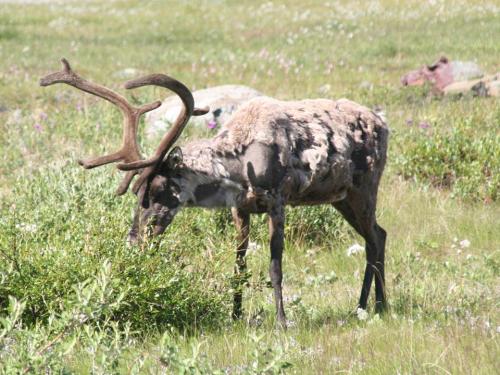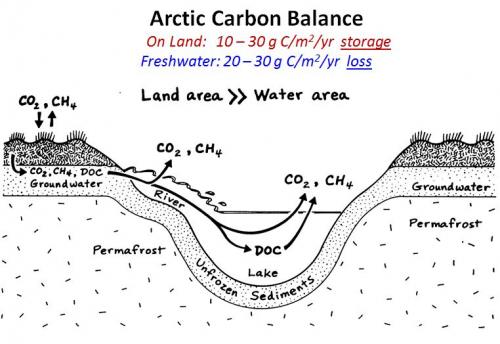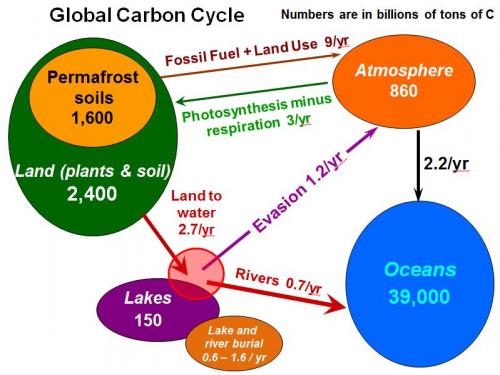I’ll be leaving Toolik in few days, heading for Fairbanks to meet Tanya and travel around Alaska. Spending 3 weeks here has been an amazing experience and I’m looking forward to bringing the tundra into my environmental science classroom this fall.

In the past 2 ½ weeks I’ve been trying to explain the team’s complex work on the tundra carbon cycle. For years the team has been taking thousands of samples from the soil and water from the Brooks Range to the Arctic Ocean to understand how carbon moves across the landscape. They’ve even been doing DNA analysis of the microbes that convert organic matter to CO2 and methane, and studying the effect of sunlight in making it easier for microbes to break down organic matter.
Now that I’m nearing the end of the expedition, I want to give you an idea of the big picture – what the team is learning about carbon. First, though, keep in mind why the tundra carbon cycle is so important:
- there’s about 1,600 billion tons of carbon locked up in frozen organic matter in permafrost carbon. That’s more than twice as much as in all the earth’s atmosphere;
- the Arctic is experiencing the most extreme warming trends on earth over the past 100 years, which is causing permafrost to thaw; and
- thawing permafrost can release previously frozen organic matter into the environment, making it available to microbes that convert it to the heat-trapping gases CO2 and CH4 (methane), which can promote climate change.
We to understand need the fate of carbon from thawing permafrost to understand how climate might change in the future.
So what has the team found? This diagram by George Kling shows the current understanding of the flow of carbon across the Arctic landscape.

CO2 from the air is taken in by the plants through photosynthesis; when plants die and break down their C either goes back into the air, or it moves into the groundwater and unfrozen sediments in the form of CO2, CH4, or dissolved organic carbon (DOC). The CO2, CH4 and DOC then get carried into rivers and lakes where sunlight and microbes break down DOC and release CO2 and CH4 back to the air.
So, if we’re concerned about the buildup of the heat-trapping gases CO2 and CH4 in the air, the key question is: how much CO2 and CH4 are being released to the air by the microbes compared to how much CO2 the plants are taking in from the air through photosynthesis. As you can see at the top of the diagram, according to the team’s work it appears that:
- on land carbon is actually building up on an annual basis, with more C taken in through photosynthesis than being released by microbial decomposition;
- in lakes and streams, however, the situation is the opposite, with more C being released than is taken in.
The Big Picture
This is another diagram by showing the storage and flow of C in the global carbon cycle.

This diagram shows how lakes are a key player in the cycle. Between land and air, more carbon is flowing into the land than flows out to the air (about 3 billion tons), making the land a carbon “sink.” However, an almost equal amount, 2.7 billion tons C, flows from the land to the water every year, and this C can either (1) be stored in lakes and sediment; (2) flow into rivers and out the ocean; or (3) be converted to CO2 and CH4 and be released (“evaded”) to the atmosphere. Thus, it seems that one of the keys to understanding carbon flow on the tundra is to get a better understanding of the fate of carbon as it flows in and out of lakes, and how that flow might change as climate warms even more.
Of course, the burning of fossil fuels and deforestation has an overwhelming impact on flow of C to the atmosphere, but even if we eventually curb our CO2 emissions from fossil fuel we’ll still need to understand the fate of the C from thawing permafrost.
For thousands of years the tundra has been a carbon “sink,” taking in much more carbon from the atmosphere and locking it away in permafrost than it released to the air. That’s why the tundra has that huge accumulation of 1,600 billion tons of carbon. PermafrostPermanently frozen ground. has played an important role in sequestering C and regulating the concentration of CO2 and CH4 in the atmosphere.
However, as climate warms and permafrost thaws, it appears that the tundra is becoming less of a carbon sink, and could in the future even become carbon neutral or a carbon source.
The team will continue to intensively study the flow of carbon across the tundra landscape to understand how the flow of carbon may change as Arctic temperatures continue to warm, and what the impact will be on climate.



Comments